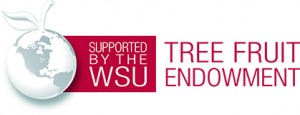Written by Tianna DuPont, WSU Extension. September 16, 2025. Reviewed by Bernardita Sallato, WSU Extension, Rebecca Schmidt Jeffris, USDA-ARS
Before closing-down for the season consider a few fall applications important for next season’s success.
Sulfur and Lime Sulfur – Farming for Next Year
With increasing acreage in IPM where primarily selective materials are used rust mite and blister mite have become more common this season. For example, almost 40% of 78 Scouting Network blocks have rust mite detectable at the end of the season last week. Pear rust mite overwinter in bark crevices behind loose bud scales usually on 2- to 3-year old wood and females will emerge when buds start to expand in the spring where feeding on developing fruit clusters can damage fruit very early in the season. Post harvest (as well as prebloom) sulfur applications can be important to suppress rust mites and are relatively nondisruptive to natural enemies (Riedl and Shearer, 1987). Fall is also a good time to prevent Pearleaf blister mite. The best timing for chemical controls is after harvest when the mites migrate from leaf blisters to terminal and fruit buds where they are exposed there until bud swell in spring. Pre-bloom treatments can prevent fruit damage that occurs just before and during bloom.
Fall Nutrients
Nutrition is important for pear productivity. Low potassium and nitrogen can reduce fruit size. Boron is critical for flower bud formation (Peterson and Stevens, 1994). Small annual applications of boron are recommended rather than waiting until there is a problem. Boron deficiency symptoms are subtle and can cause small yield reductions for multiple years before they become noticeable. WSU recommends 0.5 lbs of actual boron per acre applied as a foliar at postharvest (and prepink) timing (for example 3 lbs of 17% Boric acid (H₃BO₃): e.g. Chemguric boric acid 17 or Morbor 17) for boron maintenance plus a surface broadcast soil application every three years or when soil tests are below 0.5 mg/kg. Postharvest boron applications need to be in September when leaves are still green “to build up good flower bud formation,” Musacchi explained at a past workshop. For more information, see Crop Protection Guide Nutrient Applications http://cpg.treefruit.wsu.edu/ and Boron Nutrition in Deciduous Tree Fruit Orchards. Fall nitrogen applications build up reserves then remobilized for bud, leaves and fruit development the following year. Time foliar N applications when needed after harvest but before natural leaf drop to ensure absorption and remobilization. Combining boron plus urea has shown better uptake than boron alone.
For more information
Sallato, B. 2024. Fall Nutrient Sprays in Tree Fruit. Washington State University Extension Publication FS365E. Washington State University.
Sallato, 2018. Leaf tissue analysis. Fruit Matters.
Sallato, B, T. DuPont, D. Granatstein. 2019. Tree Fruit Soil Fertility and Plant Nutrition in Cropping Orchards in Central Washington. Washington State University Extension Publication EM119E. Washington State University.
Pearleaf and Appleleaf Blister Mites. Orchard Pest Management.
Pear Rust Mite. Orchard Pest Management.
References
Peterson, A.B., Stevens, R.G., 1994. Tree Fruit Nutrition shortcourse proceedings. Good Fruit Grower, Yakima, WA.
Riedl, H., Shearer, P.W., 1987. Pear prebloom sulfur sprays for rust mite control, 1987. Arthropod Management Tests 43(A).
